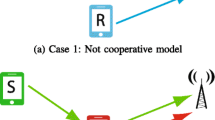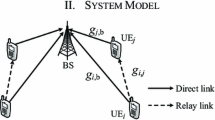Abstract
Heterogeneous networks improve the spectrum efficiency and coverage of wireless communication networks by deploying low-power nodes on top of the conventional network nodes. In this paper, we consider a heterogeneous cellular network with multiple low-power relay nodes (RN) deployed in each cell using in-band wireless backhaul link between the RN and the base station (BS). The RNs work cooperatively with the BSs on the downlink communication towards the user equipments. Due to the disparity between the transmit powers of the BSs and the RNs, mobile association schemes developed for the conventional homogeneous networks may lead to a highly unbalanced traffic load distribution with most of the traffic being concentrated on the BSs. In this paper, we propose a new mobile association framework for the heterogeneous wireless networks with node cooperation. The proposed framework aims to maximize the network capacity and balance the traffic load among the network nodes. A pseudo-optimal solution is obtained for the proposed mobile association framework using a centralized gradient-descent algorithm. To enable online implementation, we further introduce a distributed algorithm using a pricing mechanism. Numerical results show that a prominent improvement in network capacity can be achieved by the proposed load balancing-based mobile association scheme compared with the conventional counterpart. Moreover, compared with the pseudo-optimal solution, the proposed pricing-based distributed algorithm only suffers a small loss in network capacity and thus can be considered as an efficient real-time implementation alternative.







Similar content being viewed by others
References
3GPP TR36.814. (2010). Further advancements for E-UTRA physical layer aspects v9.0.0.
Pedersen, K. I., Kolding, T. E., Frederiksen, F., et al. (2009). An overview of downlink radio resource management for UTRAN long-term evolution. IEEE Communications Magazine, 47, 86–93.
Kyuho, S., Song, C., & Veciana, G. (2009). Dynamic association for load balancing and interference avoidance in multi-cell networks. IEEE Transactions on Wireless Communications, 8, 3566–3576.
Hu, R. Q., Yu, Y., Cai, Z., Womack, J., & Song, Y. (2010). Mobile association in a heterogeneous network. IEEE International Conference on Communications (pp. 1–6)
Qualcomm Europe. (2008). Range expansion for efficient support of heterogeneous networks, TSG-RAN WG1 #54bis R1–083813.
Li, Q., Hu, R. Q., Qian, Y., & Wu, G. (2012). Cooperative communications for wireless networks: techniques and applications in LTE-advanced systems. IEEE Wireless Communications Magazine, 19, 22–29.
Brickley, O., Rea, S., Pesch, D. (2005). Load balancing for QoS enhancement in IEEE802.11e WLANs using cell breathing techniques, Proceedings IFIP International Conference on Mobile and Wireless Communications Networks.
Gong, H., & Kim, J. (2008). Dynamic load balancing through association control of mobile users in WiFi networks. IEEE Transactions on Consumer Electronics, 54, 342–348.
Yen, L. H., Li, J. J., & Lin, C. M. (2011). Stability and fairness of AP selection games in IEEE 802.11 access networks. IEEE Transactions on Vehicular Technology, 60, 1150–1160.
Mach, P., Bestak, R., & Becvar, Z. (2011). Optimization of association procedure in WiMAX networks with relay stations. Telecommunication Systems, 52(3), 1694–1704. doi:10.1007/s11235-011-9661-7.
Wu, Y., Yang, K., & Chen, H. H. (2006). ARCA: An adaptive routing protocol for converged ad hoc and cellular networks. IEEE/KICS Journal of Communications and Networks, Special Issue on Broadband convergence Network, 8, 422–431.
Liu, Y., Hoshyar, R., Yang, X., & Tafazolli, R. (2006). Integrated radio resource allocation for multihop cellular networks with fixed relay stations. IEEE Journal on Selected Areas in Communications, 24, 2137–2146.
Yu, Y., Hu, R. Q., Bontu, C. S., & Cai, Z. (2011). Mobile association and load balancing in a cooperative relay cellular network. IEEE Communications Magazine, 49, 83–89.
Hou, J., Yang, J., & Papavassiliou, S. (2002). Integration of pricing with call admission control to meet QoS requirements in cellular networks. IEEE Transactions on Parallel and Distributed Systems, 13, 898–910.
Niyato, D., & Hossain, E. (2005). Call admission control for QoS provisioning in 4G wireless networks: Issues and approaches. IEEE Networks, 19, 5–11.
Lee, J. W., Mazumdar, R. R., & Shroff, N. B. (2005). Downlink power allocation for multi-class wireless systems. IEEE/ACM Transactions on Networking, 13, 854–867.
Badia, L., Merlin, S., Zanella, A., & Zorzi, M. (2006). Pricing VoWLAN services through a micro-economic framework. IEEE Wireless Communications, 13, 6–13.
Wang, J., Chen, M., & Leung, V. C. M. (2011). A pricing-based approach to optimize resource sharing between cellular data networks and WLANs”. Telecommunication Systems, doi:10.1007/s11235-01109451-2.
Zhang, Y., Huang, L., Xu, H., & Yang, Z. (2011). An incentive energy-efficient routing for data gathering in wireless cooperative networks. Telecommunication Systems, doi:10.1007/s11235-011-9478-4.
Huang, J., Berry, R. A., & Honig, M. L. (2006). Distributed interference compensation for wireless networks. IEEE Journal on Selected Areas in Communications, 24, 1074–1084.
Wang, F., Krunz, M., & Cui, S. (2008). Pricing-based spectrum management in cognitive radio networks. Journal of Selected Topics in Signal Processing, 2, 74–87.
Author information
Authors and Affiliations
Corresponding author
Rights and permissions
About this article
Cite this article
Li, Q., Hu, R.Q. & Wu, G. Mobile association for wireless heterogeneous networks with cooperative relays: optimal framework and implementation schemes. Telecommun Syst 60, 17–27 (2015). https://doi.org/10.1007/s11235-014-9918-z
Published:
Issue Date:
DOI: https://doi.org/10.1007/s11235-014-9918-z




